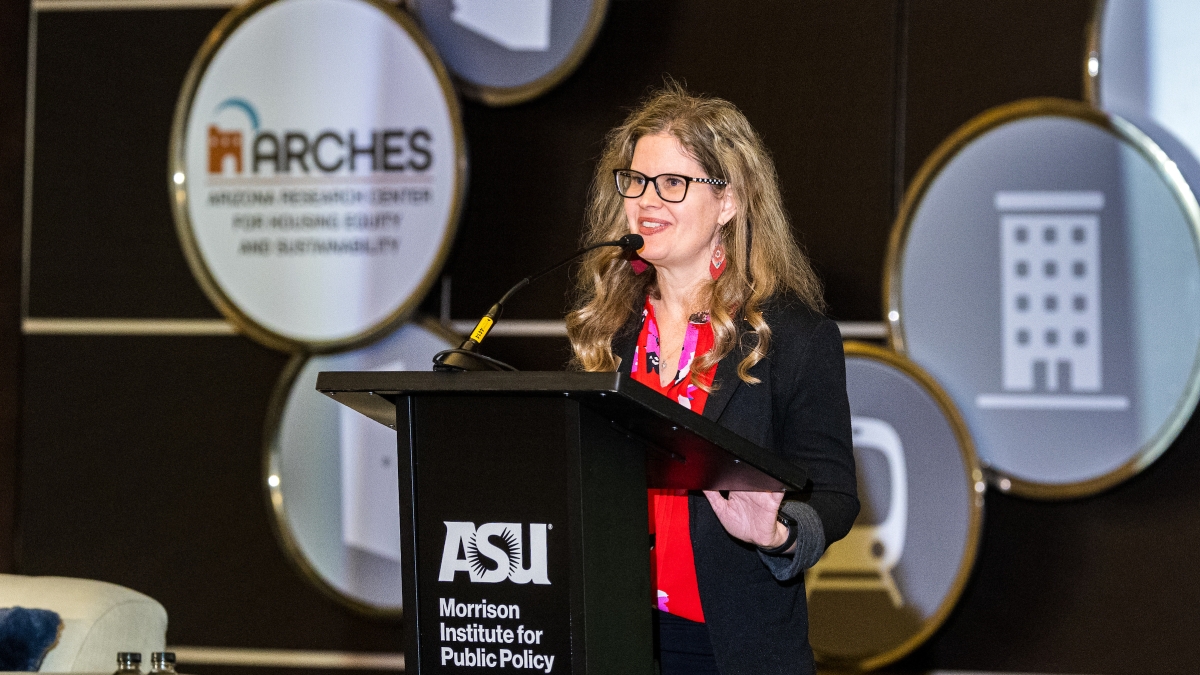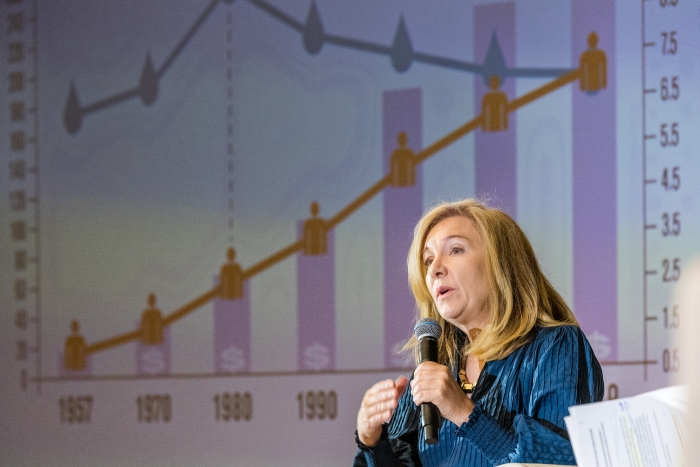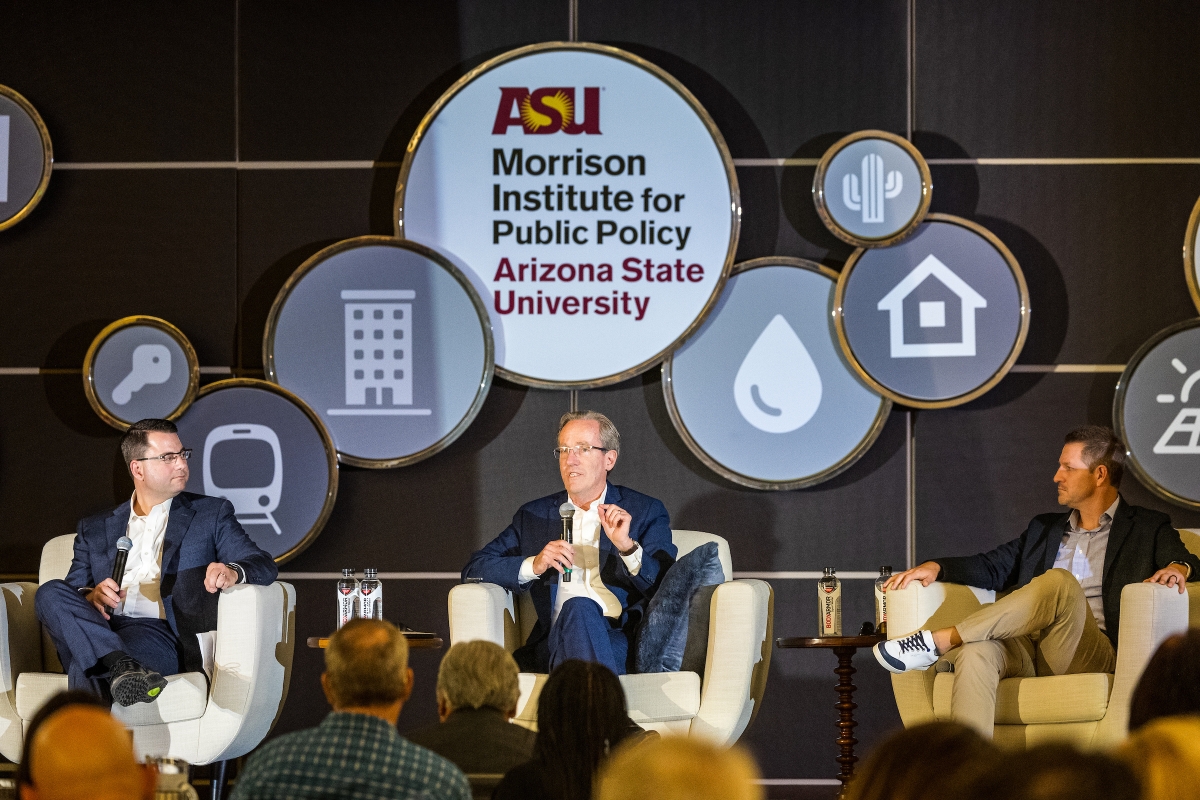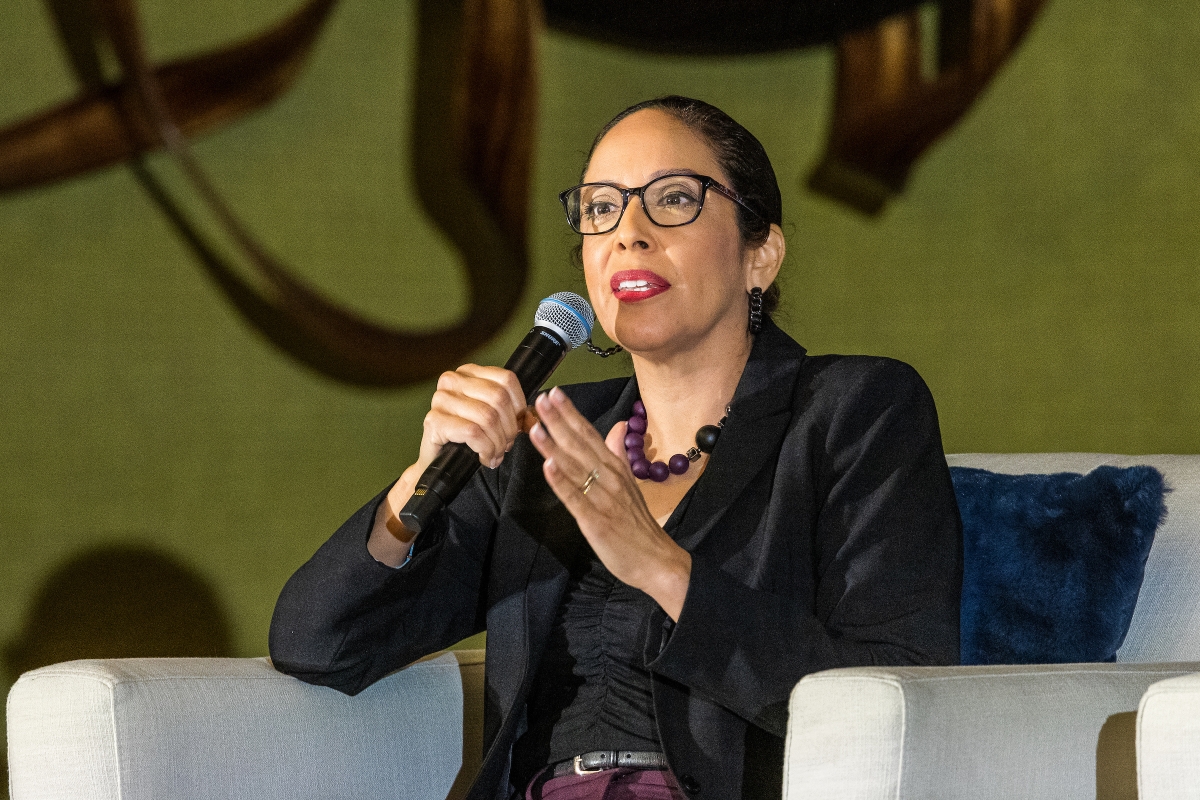New ASU report addresses affordable housing crisis in Arizona

Alison Cook-Davis, director of research at the Morrison Institute, discussed the results of a new report on the housing crisis released by the Arizona Research Center for Housing Equity and Sustainability, of which she is co-director, at the Housing and Water Policy Summit at the Renaissance Phoenix Downtown Hotel on Friday, Aug. 16. Photo by Charlie Leight/ASU News
A new report from Arizona State University shows that the state is in a housing crisis, with rents skyrocketing 72% from 2010 to 2022 and home-buying being out of reach for much of the population.
In addition, critical concerns about the future of the water supply and the energy grid are complicating housing development and economic growth.
But a gathering of top experts in the state revealed that the picture is not entirely gloomy. The Housing and Water Policy Summit, held Friday by the Morrison Institute for Public Policy at ASU, showed how municipal and state governments are working to create more affordable housing and how other stakeholders are addressing the balance between economic growth and strategic resource management.
“Groundwater across the state is a hugely valuable supply,” said Kathryn Sorensen, research director of the Kyl Center for Water Policy at ASU who moderated a panel discussion titled “Envisioning Smart Growth” at the summit.
“There isn't enough water for everything, right? Human wants are always unlimited. Our ability to meet those wants is always somewhat limited. I hope you think of these trade-offs in terms of which developments are worth the water.”
The “State of Housing in Arizona Report,” released at the summit, outlined several factors driving the state’s housing crunch. The report is the first created by the Arizona Research Center for Housing Equity and Sustainability, funded by the U.S. Department of Housing and Urban Development and housed in the Morrison Institute.
“Access to housing that is affordable, or housing that costs 30% or less of a household income, is essential for individuals and communities to thrive and is recognized as a fundamental human right,” said Alison Cook-Davis, director of research at the Morrison Institute and co-director of the Arizona Research Center for Housing Equity and Sustainability.
“However, Arizona is confronting a housing crisis as supply and affordability have markedly declined over the past decade. Arizona residents are increasingly experiencing housing insecurity and the housing crisis has become a central issue for our state and local governments.”
Among the top takeaways of the report:
- Arizonans’ incomes are not keeping up with rent prices. Minimum wage workers would need to work 86 hours per week to reach the annual income needed, $62,252, to afford a two-bedroom home. In 2022, nearly half of all renters were cost-burdened — paying more than 30% of their income toward housing — the highest percentage of cost-burden since 2010.
- There’s not enough affordable and available housing for extremely low-income households. This gap increases the risk of evictions and homelessness. Moreover, 26% of publicly subsidized low-income housing units are set to expire in the next 30 years.
- The median sale price of a home increased by 57% from 2019 to 2023, to $423,400. At the same time, high home values and lower interest rates during the pandemic allowed existing homeowners to refinance and lower their housing costs, which reduced the supply of houses for sale. That lack of supply, along with higher interest rates, put home-buying out of reach for many first-time homebuyers.
- Affordability ratios (price to income ratio) are higher for Hispanic or Latino, Black or African American, and American Indian and Alaska Native populations than for white and Asian households.
- Arizona’s population growth has outpaced the growth of all types of housing. Since 2010, the population has grown by 22% but housing units have increased by only about 12%.
- Some cities, including Tempe, Phoenix and Tucson — as well as the state Legislature — have changed policies to create more affordable housing, such as approving accessory dwelling units, easing rezoning and preventing income discrimination. Federal funding will also create more units.
The summit also addressed topics that are intertwined with housing in the state’s future.
Water challenges
Sarah Porter, director of the Kyl Center for Water Policy, housed in the Morrison Institute, gave a talk titled “Water is Not the Problem – Yet.”
“So to our question, are we running out of water for housing in Arizona? The answer to this question is kind of complicated,” Porter told the crowd.
“We're not running out of water for housing, but we are challenged to find the water for some types of housing.”
Groundwater is a non-renewable supply. To acquire approval for new building, developers must prove that they have a 100-year supply of water, which is possible in communities served by municipal suppliers, such as the cities of Phoenix, Tempe, Glendale, Chandler, etc.
But further housing development may be affected in areas outside of municipal suppliers, such as the fast-growing communities of Buckeye and Queen Creek, she said.
“It's a water problem for the region because it means growth that had been expected and planned is now challenged to figure out a different water solution,” she said.
Increased housing density will ease pressure on the water supply, Porter said.
“Imagine duplexes or triplexes or other types of multifamily housing, which means more water per acre is being used indoors. And so more of that water can be kept in the system — reclaimed, treated and used over and over again,” she said.
“That's the future for water management of many of the more built-out cities in central Arizona.”
The power grid
Electricity demand has jumped over the past few years, according to Ted Geisler, president of Arizona Public Service. Reasons for that include increased computing demands (including artificial intelligence), more manufacturing and more electric vehicles.
“When we fast forward between now and 2031, we think electric demand on the Arizona grid will grow by at least 40%,” he said.
Driving that increase is higher nighttime temperatures but also more commerce, including big data centers. In fact, APS is expecting several very large-scale power users to connect to the state’s grid over the next few years.
“But we're letting them know that we likely can't build the grid fast enough to connect them on their desired timing. And we need to be careful not to connect them faster than we can build infrastructure to ensure that we don't put reliability at risk,” he said.
“We have to ensure that along with reliability, we keep it affordable. It's one of the key attributes for why people move here.”
Economic growth
As president and CEO of the Greater Phoenix Economic Council, Chris Camacho said that over the past decade, the landscape has changed for companies interested in investing in Arizona.
“Ten years ago, the conversation would largely be about technical talent, education and being a low-cost market,” he said.
“Fast forward to today, it's air quality, power reliability and — no question — water.”
Camacho said that much of industry coming to Arizona, including the big semiconductor plants, are not polluters.
“These are not big smoke stack, VOC-yielding enterprises anymore. This is clean manufacturing.”
He said his role is like a consultant.
“I help them to analyze risk and timing of policy and effects of, ‘Can you use effluent instead of potable water?’” he said.
“We have to think very intentionally about the market we want to become and maybe the place we don't want to become.”
The human factor
Anna Maria Chavez, president and CEO of the Arizona Community Foundation, said that it will take strong leadership to create equity in housing.
“How do we ensure that the older population is being able to age in place in Arizona and that the young generation is able to get an education to earn a livable wage, to be able to buy a home? Because we know there's a direct correlation between home ownership and wealth accumulation,” she said.
She encouraged the elected officials at the summit to work on creating more affordable housing options.
“Home ownership builds equity in families exponentially faster than anything else,” she said.
“I am bringing the human side of this data to you because I'm a case in point. My parents, because of their ability to buy a home in Eloy, Arizona, were able to get a second mortgage on that house so that I could go to Yale University. I broke the poverty cycle from my family. So for me, it matters.”
Arizona as the future
Wellington “Duke” Reiter is the founder and executive director of the Ten Across project, which looks at the Interstate-10 corridor across the Sunbelt as the “premier observatory for the future.”
“I would say our thesis is this — that if you want to see the future of this country, this is where it's going to happen,” said Reiter, who also is a senior advisor to ASU President Michael Crow and executive director of University City Exchange at ASU.
“This is where the growth is. This is where the greatest disparity economically is. It's also the place of greatest demographic change and it's on the front lines of climate change.
“You take all those factors and you have the recipe for understanding where we're moving and our ability to take on — which is really hard, societally — the knowledge that we have about the future.”
Reiter said that no society has ever had more access to data analytics, and he cited examples of goals that Arizona needs to achieve in the coming decades.
“Are you despondent about what seems almost impossible to achieve by those dates? Or can we give you the license or the tools to be involved in addressing the data in a productive way?” he said.
“We hope the latter is the case.”
More Local, national and global affairs

ASU champions veterans' success and national security
Arizona State University has a long history of supporting the military — whether through veteran education, groundbreaking research that improves their well-being, or innovative programs that…

ASU named a top producer of faculty, student Fulbright awards for 2024–25
When faculty and students travel abroad on a Fulbright award, they’re often working at the forefront of current events and cultural change.David Androff, a professor in the School of Social Work at…

Overdose crisis involves more than opioids, says ASU social work professor
News coverage about the escalating number of drug overdoses in the United States can lead many to conclude that so long as you’re not overdosing yourself, the crisis doesn’t really affect you.Wrong,…





